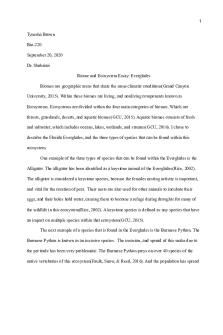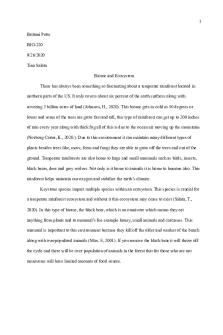BIO-220 Biome and Ecosytem Essay PDF

| Title | BIO-220 Biome and Ecosytem Essay |
|---|---|
| Course | Environmental Science |
| Institution | Grand Canyon University |
| Pages | 4 |
| File Size | 61 KB |
| File Type | |
| Total Downloads | 109 |
| Total Views | 168 |
Summary
Download BIO-220 Biome and Ecosytem Essay PDF
Description
Mireille Beutamboh BIO-220 April 19, 2020. Dr. Muthu Kuchanur. Biome and Ecosystem A biome represents an ecological community categorized by its physical characteristics like soil, its climate and therefore the life it supports. (Brenner, 2019.) That being said, an ecosystem includes living things (plants, animals, and organisms) in a given area that interacts with each other, also due to the non-living environments (weather, earth, sun, soil, climate, atmosphere) that surround the living things. (Maximum Yield, 2019.) There are different types of biomes and ecosystems, but for the sake of this essay, I will be talking about the Desert Biome and the Saharan Desert ecosystem, while looking at the keystone, invasive, and endangered species found in the Desert Biome/Saharan Desert. First, an example of a keystone species found in the Desert Biome is the desert tortoises. According to Animal Network Editors (2017), a keystone species may be a species that heavily alters the lives of the opposite animals and plants around them, and, when removed, the complete ecosystem suffers. Desert tortoises, for instance, can dig extensive tunnel systems, and per se, they supply shelter for a large range of other species that can't dig burrows themselves. The motive why the desert tortoises are necessary within the Saharan desert is that as a desert adaptation, the tortoises can store water in their bladders for months, and their skin and shell are waterproof. During dry spells, they swap from excreting urea, which contains plenty of water, to acid crystals. When water is reachable, however, a tortoise’s bladder can hold over forty percent of its weight in water, urea, acid, and waste (Sun Staff, 2016)
Added to the keystone species, an invasive species as defined by the National Oceanic and Atmospheric Administration (NOAA, 2020), is an organism that causes ecological or economic harm during a new environment where it's not native. An example of invasive species found in the Sahara Desert is the Tamarisk plant. The Tamarisk plant, also called Tamarix Senegalensis, can be found within the western coastal zone of the Sahara. This plant is described as a little twiggy shrub that grows in saline desert soil and seashores. It has dry, scale-like leaves and flowers. (Nag, O.S, 2019.) This shrub has many bad effects on ecosystems and human resources, which consists of reduced native plant and animal diversity, a stockpile of salt in soils, prolonged water loss, narrowing and incision of river channels, and high fire risk. To mitigate tamarisk, a mixture of treatments, including cutting, bulldozing, root raking, burning, herbicides. Also, relying solely on cutting with chainsaws isn't effective unless root crowns are removed or cut stumps are treated with herbicide. (Weisberg, 2009.) Apart from the keystone and the invasive species, we also have species within the Sahara Desert. Despite the cruel desert heat, a variety of animal species boards the Sahara. However, due to human invasion, hunting, drought, and habitat loss, several species are on the verge of extinction.one of the species within the Sahara Desert is the desert antelope. The Saharan antelopes have suffered from over-hunting, drought, and loss of habitat. they're listed as severely endangered, with less than 300 antelopes left in Chad and Niger. (Jauregui, n.d.) Their role within the Sahara ecosystem can't be underestimated because the grazing of the desert antelopes is targeted on certain plants that are essential for the prevention of Sahara's progressive spread. The course of actions suggested by experts from conservation groups includes protecting the surviving population of desert antelopes by ending illegal hunting and reinforcing the remaining population through the introduction of captive-bred stock.
In conclusion, the Desert Biome/Saharan Ecosystem is made up of the species like the keystone species, the invasive species, and the endangered species. It should be noted that these species have distinctive roles to play in the desert biome.
References Animals Network Editors. (2017). Desert Tortoise. Retrieved from https://animals.net/deserttortoise/ Brenner, L. (2020, April 19). What Are Seven Land Biomes? sciencing.com. Retrieved from https://sciencing.com/seven-land-biomes-7650971.html Jauregui, R. D. (n.d.). Endangered species in the Sahara Desert. Animals - mom.me. https://animals.mom.me/endangered-species-sahara-desert-3583.html Maximum Yield. (2019). Ecosystem. Retrieved from https://www.maximumyield.com/definition/483/ecosystem Nag, O.S. (2019). Plants That Grow in The Sahara Desert. Retrieved from https://www.worldatlas.com/articles/plants-that-grow-in-the-sahara-desert.html National Oceanic and Atmospheric Administration. (2020). What is an invasive species? Retrieved from https://oceanservice.noaa.gov/facts/invasive.html Sun Staff. (2016). Why the desert tortoise is so important to our home in the Mojave? Las Vegas Sun. Retrieved from https://lasvegassun.com/news/2016/aug/21/five-minute-expertdesert-tortoise-mojave-desert/ Weisberg, P. (2009). Tamarisk. Nevada Humanities. Retrieved from http://www.onlinenevada.org/articles/tamarisk...
Similar Free PDFs

BIO-220 Biome and Ecosytem Essay
- 4 Pages

Biome and Ecosystem Essay
- 3 Pages

Biome and Ecosystem Essay
- 4 Pages

Biome and Ecosystem Essay
- 4 Pages

Biome and ecosystem Essay
- 3 Pages

Biome and Ecosystem Essay
- 3 Pages

Bio220 1 -
- 5 Pages

Biome and Ecosystem
- 5 Pages

Biome and Ecosystem
- 5 Pages

Biome and Ecosystem
- 4 Pages

Biome Chart
- 2 Pages
Popular Institutions
- Tinajero National High School - Annex
- Politeknik Caltex Riau
- Yokohama City University
- SGT University
- University of Al-Qadisiyah
- Divine Word College of Vigan
- Techniek College Rotterdam
- Universidade de Santiago
- Universiti Teknologi MARA Cawangan Johor Kampus Pasir Gudang
- Poltekkes Kemenkes Yogyakarta
- Baguio City National High School
- Colegio san marcos
- preparatoria uno
- Centro de Bachillerato Tecnológico Industrial y de Servicios No. 107
- Dalian Maritime University
- Quang Trung Secondary School
- Colegio Tecnológico en Informática
- Corporación Regional de Educación Superior
- Grupo CEDVA
- Dar Al Uloom University
- Centro de Estudios Preuniversitarios de la Universidad Nacional de Ingeniería
- 上智大学
- Aakash International School, Nuna Majara
- San Felipe Neri Catholic School
- Kang Chiao International School - New Taipei City
- Misamis Occidental National High School
- Institución Educativa Escuela Normal Juan Ladrilleros
- Kolehiyo ng Pantukan
- Batanes State College
- Instituto Continental
- Sekolah Menengah Kejuruan Kesehatan Kaltara (Tarakan)
- Colegio de La Inmaculada Concepcion - Cebu




